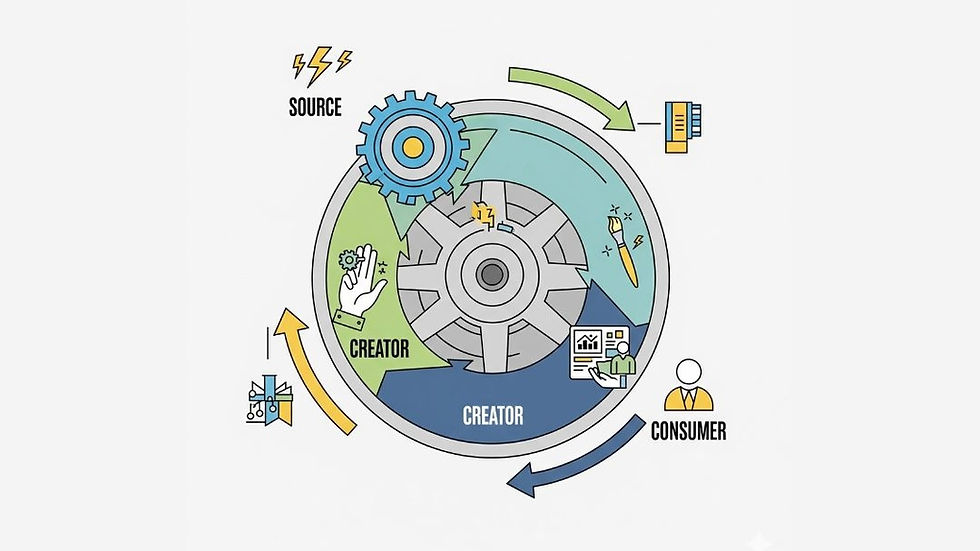The New Business Flywheel: Balancing Internal and External Engines
- Jayda Jacobs
- 6 days ago
- 4 min read
In today’s digital age, even the most established brands face challenges in maintaining their dominance. The once-robust logistics and efficient supply chains that businesses relied on to thrive are now taking a back seat to another system.
While the internal engine remains vital for operational performance, it’s no longer sufficient on its own. The digital landscape has introduced a new dynamic, one that demands a second engine to drive trust, engagement, and long-term success. This is the foundation of the "Two-Engine Model," where businesses must balance their internal operations with a strong, public-facing digital presence. Without this balance, even the most powerful brands risk losing their edge.
Table of Contents
The Problem: The Cracks in the Foundation
The traditional internal sales loop, while still crucial, is no longer enough to secure a company's future. As consumer preferences shift and digital platforms evolve, cracks begin to form in the foundation of even the most established brands. These vulnerabilities can slow down, or ultimately break, a company’s internal loop if they fail to adapt to the wider digital landscape.
The Internal Engine (The Old Flywheel)
At its core, a traditional business model revolves around a simplified version of the Jim Collins flywheel concept. Let’s break this down:
Lower Costs: By reducing operational costs, brands can offer products at more competitive prices.
Higher Volume: More competitive pricing leads to increased sales volume, further driving down costs through economies of scale.
Repeat Customers: Good service and a satisfactory product experience generate loyal customers, leading to repeat sales.

This internal engine is critical for success. However, the reliance on it as a standalone system is misguided. This engine operates in a vacuum, increasingly dependent on external factors that can disrupt its flow. In an era where consumers voice their opinions online, the internal process must integrate with the public-facing elements of a brand's strategy.
The Public Engine (The New Flywheel)
Enter the Public Digital Engine, a new model that incorporates the digital ecosystem. This engine operates through three interconnected parts:
The Source: Digital platforms such as Google, Instagram, TikTok, and others serve as conduits for brand communication.
The Creator: Brands or individual creators produce relevant content, including advertisements, social media posts, and videos.
The Consumer: The audience engages with this content, driving the cycle forward.
Understanding how this flywheel turns is crucial. For the engine to work, consumers must find value in the content provided. This could be in the form of entertainment, education, or genuine engagement. If the content feels like a gimmick or scam, trust erodes, and the flywheel stalls.

Successful engagement leads to views, likes, shares, and comments, which enhance the visibility of the brand across digital platforms. As reach increases, the platform gains value as well, creating a mutually beneficial cycle that is essential in the digital age.
Where the Engines Break Down
What happens, however, when brands cling to an outdated model? Let's explore some examples:
The Guru Model
In cases where brands fail to adapt their messaging to consumer expectations, they become what we term the "Guru Model." Here, the marketing content becomes overly sales-focused without providing real benefits to the consumer. These messages often come off as "spam," resulting in a broken flywheel effect.
Brands with unrealistic engagement practices, such as fake receipts or manipulated reviews, quickly lose consumer trust. The moment the audience disengages, the brand faces long-term consequences.
The Major Corporation Example (Expedia)
Even powerhouse brands like Expedia aren’t immune to the pitfalls of a broken flywheel. While they’ve made significant strides in advancing their internal operations, such as committing to AI development and streamlining their services, their external engine tells a different story. A quick glance at their social media pages reveals a flood of comments from dissatisfied customers, highlighting unresolved issues and a growing disconnect between the brand and its audience.
This is a classic example of a broken external flywheel. No matter how advanced their internal operations become, the lack of trust and engagement in the public sphere undermines their efforts. Fixing internal processes alone won’t resolve the deeper issue. To regain momentum, Expedia must address the cracks in their public-facing digital engine, rebuilding trust and fostering authentic connections with their audience.
The Ad Platform Problem
Even the most finely-tuned marketing strategies can falter due to issues inherent to ad platforms. The “spray and pray” tactics employed by many marketing departments lack nuance. Instead of targeting specific audiences, brands blast ads to broad demographics, often reaching consumers who are not even in the market for their products.
This approach not only diminishes trust but fosters a disconnect between brands and consumers. Consequently, damaging the efficacy of ad spending can result in wasted resources and ineffective campaigns.

The Path to Rebalancing
In today’s digital landscape, a brand needs more than a single operational engine to succeed. It must master both the internal and public engines, as they significantly impact one another. The public-facing digital engine has now emerged as the cornerstone of trust in modern marketing.
Here are actionable insights to help align both engines for better results:
Focus on Providing Value: Your content should be educational, entertaining, and informative. Consumers are more likely to engage when they are gaining something valuable from the interaction.
Build a Community: Shift your perspective from merely accumulating customers to fostering a loyal community. Engagement should not end with a transaction but continue through ongoing conversations.
Embrace Authenticity: Resist the temptation to chase vanity metrics. Instead of focusing solely on likes or shares, aim for significant engagement and conversations that build real relationships with your audience.
As we move forward, it's vital to remember that trust now plays a pivotal role in a brand’s success. A brand can no longer succeed on its internal strength alone. In the digital age, a brand's true power is measured by the trust it earns in the minds of its consumers.



Comments